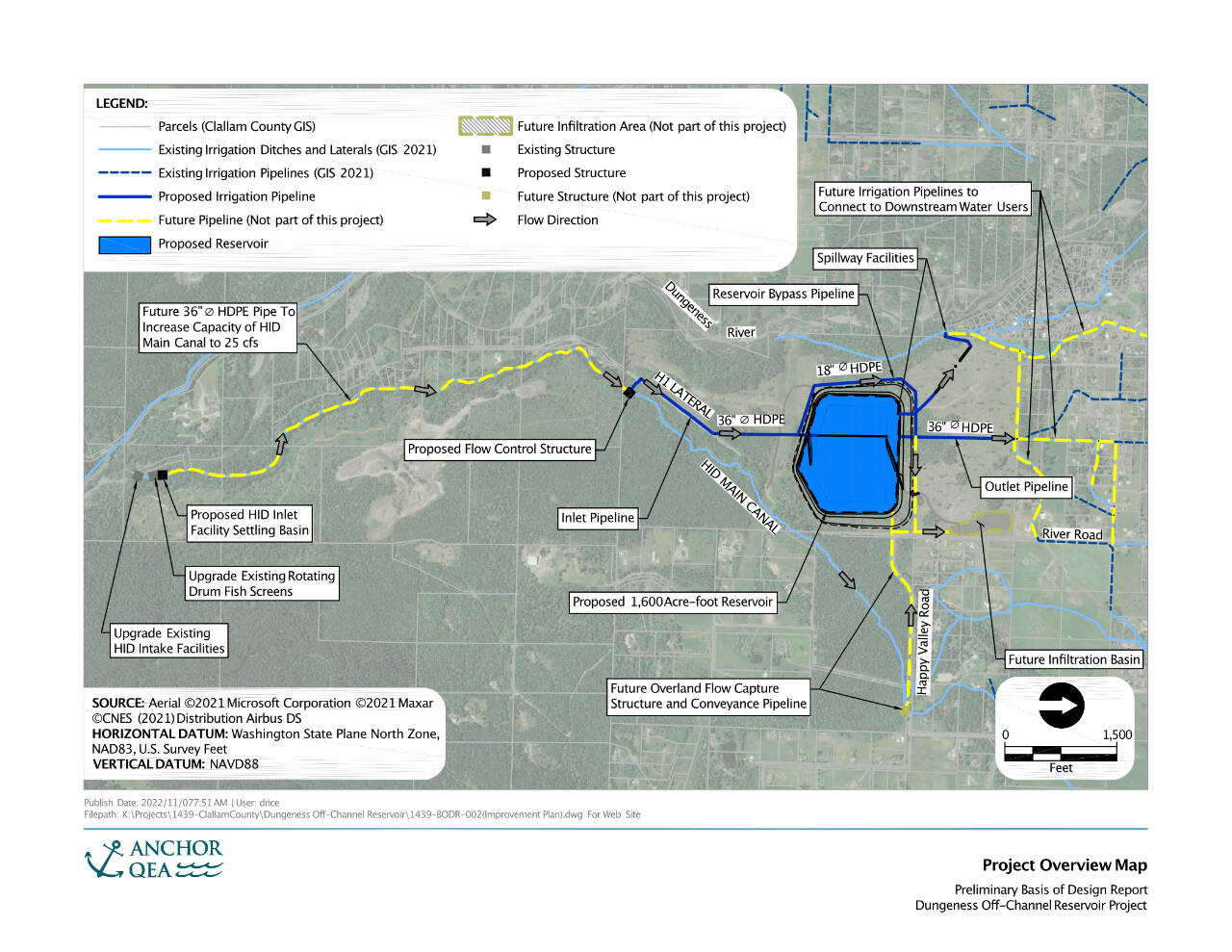Supporters of a project they say will improve salmon restoration, provide irrigation water for farmers, protect city stormwater infrastructure and establish a 400-acre county park along River Road will present a preliminary design to the public in an open house set for 6-8 p.m. Tuesday, Dec. 6, at the Dungeness River Nature Center, 1943 W. Hendrickson Road.
Community members can get more details about the Dungeness Off-Channel Reservoir at the meeting that will feature a presentation by project sponsor Clallam County and design engineers from Anchor QEA, the project’s engineering firm.
Other project supporters include the Jamestown S’Klallam Tribe and Dungeness Water Users Association.
This reservoir, supporters say, will improve late summer flows in the Dungeness River by up to 50 percent for
salmon restoration, secure late summer irrigation water for farmers and protect the city of Sequim’s stormwater, along with creating a new Clallam County park along River Road ion Sequim’s west end.
“This preliminary design represents a significant step forward on this critical project to address climate change impacts on our limited water resources,” Clallam County commissioner Mark Ozias said in a press release. “We look forward to sharing this design with the community at the Open House.”
The Dungeness Off-Channel Reservoir project was envisioned more than 10 years ago by the Dungeness Reservoir Work Group, a coalition of partners that includes Clallam County, City of Sequim, Jamestown S’Klallam Tribe,
Clallam Conservation District, Washington Department of Ecology, Washington Department of Fish and Wildlife, Washington Water Trust and the Dungeness Water Users Association, a collective of seven irrigation districts and companies.
Association president Ben Smith noted, “The off-channel reservoir is an important community project which will increase river flows in the late summer, when the fish need it most, and ensure water is available for irrigation to help maintain a healthy agricultural community in the valley.”
For more than a 100 years, residents in the Sequim-Dungeness Valley have used irrigation water directly from the Dungeness River. In the last 20 years, irrigators and others have invested considerable resources to conserve and enhance the flow of the Dungeness, home to four species of salmon and steelhead listed in the Endangered Species Act.
The Dungeness River has experienced official drought declarations in 2015, 2019 and 2021, and an extreme low flow year in 2016, project supporters noted.
In low snowpack years, there is still not enough flow in the river to support salmon and also meet out-of-stream water needs, they said. Their solution is an off-channel reservoir to store water during winter and spring when flows are plentiful, saving this water for later in the year when river flow is low.
Project details
Preliminary plans of the Off-channel Reservoir design — also known as 30 percent design — detail a 42-acre reservoir located on a parcel 1 mile south of U.S. Highway 101 on River Road, property now owned by the Washington State Department of Natural Resources.
The reservoir would capture late-winter, high river flows from the Dungeness River and store them in a 1,600-acre-foot reservoir.
Clallam County officials say they have investigated the site of the proposed reservoir, including geotechnical, environmental hazards, land surveying, cultural resources and wetland surveys.
The preliminary design, project supports said, incorporates “the highest level of safety features” to protect landowners downstream.
Carol Creasey, Clallam County project manager and hydrogeologist, said that based on field work, the proposed reservoir location has shifted east and south closer to River Road and the footprint of the project has been reduced by as much as 50 percent from a 2016 conceptual design.
Water from the reservoir will be used for irrigation to offset diversions from the Dungeness River during the late summer season — Aug. 15-Sept. 15 — when Dungeness River flows can fall as low as 50 cubic feet per second (cfs), county officials said. By using the reservoir instead of the river for irrigation, the streamflow can be increased as much as 50 percent in the late season, allowing salmon to migrate and thrive.
Reservoir water will also be used to support groundwater infiltration/aquifer recharge sites to offset new groundwater well use, officials said.
“This project can help us address increasingly frequent low snowpack years, which are exacerbated by climate change and threaten to compromise our existing restoration work,” said Ron Allen, chair and CEO of the Jamestown S’Klallam Tribe.
“These conditions promise that there will not be enough water for instream and out of stream needs in the future if we fail to act.”
The flow restoration benefits from reduced agricultural diversions will improve the health of the Dungeness watershed, project supporters said.
“Improving late Dungeness River summer flows by as much as 50 percent is proportionally among the largest flow restoration projects ever in this state and another important example of collaborative water supply planning in the watershed,” said Jason Hatch, Program Director of the Washington Water Trust.
The project, supporters said, would also alleviate flooding on roads and properties in county and City of Sequim by intercepting storm flows before they reach infrastructure and pollution-generating urban areas.
The new public park would include hiking, biking, wildlife viewing and river access opportunities, they said.
Find more information about the Dungeness Off-Channel Reservoir at clallamcountywa.gov/188/Dungeness-Off-Channel-Reservoir.



